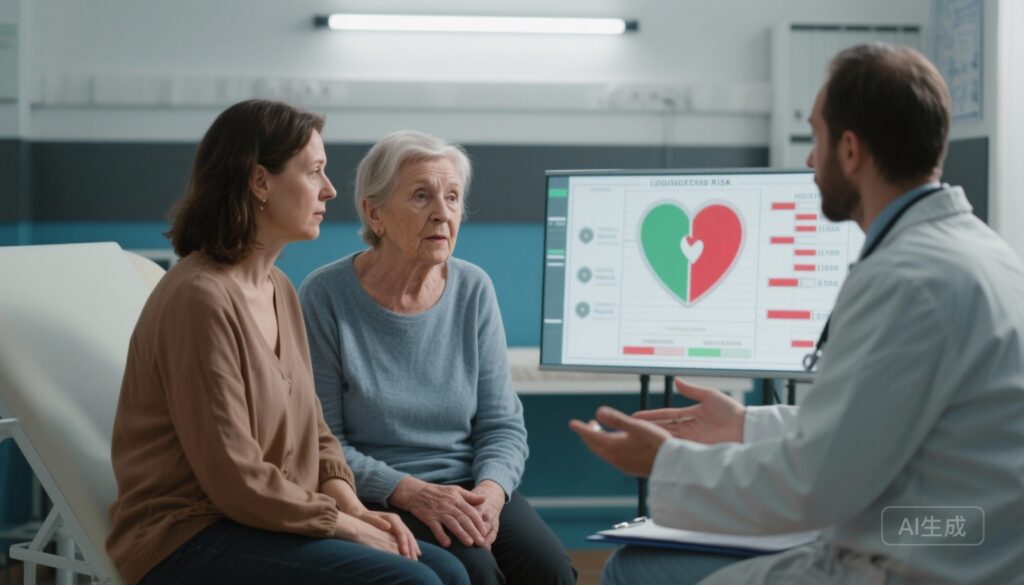Highlight
– In a secondary analysis of the Women’s Health Initiative randomized trials (n = 27,347), oral conjugated equine estrogen (CEE) with or without medroxyprogesterone acetate (MPA) reduced moderate-to-severe vasomotor symptoms (VMS) in younger postmenopausal women.
– Among women with VMS aged 50–59, CEE alone and CEE+MPA had neutral effects on atherosclerotic cardiovascular disease (ASCVD) risk over median follow-up.
– Initiation of HT in women ≥70 years with VMS was associated with increased ASCVD events; caution is advised for initiation after age 60 and HT should be avoided for symptomatic treatment in women 70 and older.
Background
Vasomotor symptoms (VMS), including hot flashes and night sweats, affect a substantial proportion of women during the menopausal transition and can significantly impair quality of life. Menopausal hormone therapy (HT) remains the most effective treatment for moderate-to-severe VMS. However, decisions about HT require weighing symptomatic benefit against potential long-term risks—most notably cardiovascular disease and venous thromboembolism. Past results from the Women’s Health Initiative (WHI) famously altered practice by reporting adverse cardiovascular signals with combined estrogen–progestin therapy in an older cohort, raising enduring questions about whether age and time since menopause modify HT’s cardiovascular effects. This secondary analysis of WHI randomized trials specifically examines ASCVD outcomes in women with VMS across age groups to better align symptomatic treatment recommendations with cardiovascular safety data.
Study design and methods
This is a secondary analysis of two randomized, placebo-controlled WHI hormone therapy trials conducted at 40 US centers between November 1993 and September 2012, with data analysis completed December 2024–May 2025. Participants were postmenopausal women aged 50–79 years. Two parallel trials were analyzed separately by uterine status: (1) CEE alone (0.625 mg/day) versus placebo among women with prior hysterectomy; (2) CEE (0.625 mg/day) plus medroxyprogesterone acetate (MPA) (2.5 mg/day) versus placebo among women with an intact uterus.
Main outcomes: the primary outcome for this analysis was atherosclerotic cardiovascular disease (ASCVD), defined as a composite of nonfatal myocardial infarction, hospitalization for angina, coronary revascularization, ischemic stroke, peripheral arterial disease, carotid artery disease, or cardiovascular death. Baseline VMS were categorized by self-report as moderate or severe. Median follow-up was 7.2 years for the CEE alone trial and 5.6 years for the CEE+MPA trial.
Key findings
Population and VMS prevalence: The pooled sample comprised 27,347 women (mean age 63.4 years); 10,739 (39.3%) had a hysterectomy (CEE alone trial) and 16,608 (60.7%) had an intact uterus (CEE+MPA trial). Moderate or severe VMS at baseline occurred more commonly in younger women: among women aged 50–59, 27.6% (CEE alone trial) and 22.4% (CEE+MPA trial) reported moderate/severe VMS. Nearly all (96.7%) women with moderate or severe VMS recalled symptoms occurring near menopause onset.
Symptom efficacy: CEE alone reduced VMS across all ages (overall relative risk [RR] for persistent moderate/severe symptoms, 0.59; 95% CI, 0.53–0.66), corresponding to a ~41% relative reduction. In the CEE+MPA trial, VMS reduction was strong in younger women but attenuated with age: age 50–59 RR 0.41 (95% CI, 0.35–0.48); 60–69 RR 0.72 (95% CI, 0.61–0.85); 70–79 RR 1.20 (95% CI, 0.91–1.59); interaction P for trend < .001. In short, CEE+MPA offered robust symptomatic benefit for women closer to menopause but not for older women in whom baseline VMS were less common.
ASCVD outcomes by age group (women with moderate/severe VMS):
- Age 50–59: Both formulations had neutral effects on ASCVD risk. CEE alone HR 0.85 (95% CI, 0.53–1.35); CEE+MPA HR 0.84 (95% CI, 0.44–1.57).
- Age 60–69: Point estimates were heterogeneous. CEE alone HR 1.31 (95% CI, 0.90–1.90) suggested a possible but not statistically clear increase; CEE+MPA HR 0.84 (95% CI, 0.51–1.39) did not indicate harm.
- Age 70–79: Both trials showed increased ASCVD risk. CEE alone HR 1.95 (95% CI, 1.06–3.59) corresponding to 217 excess events per 10,000 person-years; CEE+MPA HR 3.22 (95% CI, 1.36–7.63) corresponding to 382 excess events per 10,000 person-years. Interaction P for trend was .03 (CEE alone) and .02 (CEE+MPA).
Interpretation: For women with clinically significant VMS who are in their 50s, HT (oral CEE with or without MPA) provides meaningful symptom relief without a clear increase in ASCVD risk over the follow-up observed. Conversely, initiating the same regimens in women aged 70 and older was associated with an appreciable increase in ASCVD events.
Safety and secondary considerations
Venous thromboembolism (VTE) and stroke risks were not the primary focus of this age-stratified VMS analysis, but prior WHI reports and other studies have shown elevated VTE risk with oral estrogens, particularly in older women and with certain progestins. The current analysis underscores that age-dependent vascular vulnerability may accentuate ischemic risk when HT is started late. Importantly, the regimens studied were specific: oral CEE 0.625 mg daily, and medroxyprogesterone acetate 2.5 mg daily as the progestin component — findings should not be extrapolated without caution to other estrogen preparations, lower doses, transdermal routes, or alternate progestogens (e.g., micronized progesterone), which have different pharmacologic and thrombotic profiles.
Expert commentary and clinical perspective
These results align with the “timing hypothesis” and contemporary guideline practice: benefit–risk of HT is most favorable when started in younger postmenopausal women (commonly within 10 years of menopause or age <60), and risk increases with older age and greater time since menopause. The North American Menopause Society (NAMS) has long recommended individualized HT use for symptomatic women, favoring initiation in younger symptomatic women after risk assessment. The WHI secondary analysis adds granularity by directly assessing women who reported bothersome VMS and provides age-stratified ASCVD incidence estimates that can inform shared decision-making.
Clinical pragmatism: For symptomatic women aged 50–59 who have no contraindications (e.g., active or high risk of breast cancer, unexplained vaginal bleeding, active VTE), oral HT using the regimens studied may be presented as a reasonable option with likely symptomatic benefit and no clear excess ASCVD risk observed here. For women aged 60–69, caution and individualized discussion are appropriate — consider baseline cardiovascular risk, time since menopause, alternative routes (transdermal estrogen may lower VTE risk), lower doses, and nonhormonal therapies when risk is elevated. For women 70 and older, the data here support avoidance of initiating HT solely for VMS due to increased ASCVD risk.
Biological plausibility
Age-dependent differences in vascular response to estrogen likely reflect cumulative atherosclerotic burden, differences in endothelial function and inflammation, and prothrombotic effects of oral estrogens mediated by hepatic first-pass effects on coagulation factors. In younger, less atherosclerotic arteries, estrogen’s favorable effects on lipids and vasodilation may predominate; in older vessels with established plaque, prothrombotic or destabilizing influences may increase ischemic events. Progestin type also modifies effects; MPA has been implicated in adverse vascular outcomes in prior WHI analyses compared with estrogen alone.
Limitations
Key limitations of this analysis include its post hoc nature (secondary analysis), potential for residual confounding despite randomized allocation, and limited power to detect modest effects within some subgroups. Study regimens were restricted to oral CEE and MPA at conventional WHI doses; results may not generalize to transdermal estradiol, lower estrogen doses, or different progestins. WHI participants were recruited in the 1990s and may differ from contemporary patients in baseline risk factor profiles and background care. Finally, the age categories used are broad; time since menopause is an important modifier but was not the sole stratifier in these reported analyses.
Clinical implications and recommendations
1) For symptomatic women aged 50–59 (or within ~10 years of menopause), HT (when not contraindicated) remains an effective option for moderate-to-severe VMS and appears not to increase ASCVD risk in this WHI subgroup analysis.
2) In women aged 60–69, weigh individual cardiovascular risk, consider nonoral routes (transdermal estrogen) or lower doses, prefer shorter duration and regular re-evaluation, and discuss nonhormonal alternatives if risk is elevated.
3) Avoid initiating HT for VMS in women 70 years and older given observed increases in ASCVD events in this analysis.
4) Always individualize therapy with shared decision-making, document symptom burden, discuss alternatives (SSRIs/SNRIs, gabapentin, cognitive-behavioral strategies), and reassess benefit–risk periodically.
Research gaps
Randomized trials addressing transdermal estradiol, lower estrogen doses, and alternative progestogens in symptomatic women stratified by time since menopause are needed. Contemporary pragmatic trials enrolling younger, diverse cohorts with modern cardiovascular risk management would help refine absolute risk estimates and guide route/dose selection. Biomarker and imaging studies could illuminate mechanisms underlying age-dependent effects.
Conclusions
This WHI secondary analysis provides clinically actionable evidence: oral CEE (with or without MPA) effectively reduces bothersome VMS in younger postmenopausal women and does not clearly increase ASCVD risk in women aged 50–59, supporting guideline-concordant use in this group. In contrast, initiating these oral HT regimens in women aged 70 and older is associated with increased ASCVD, arguing against use for VMS in that age group. Clinicians should individualize therapy by age, cardiovascular risk, HT formulation and route, and patient preferences.
Funding and trial registration
The WHI trials were supported by the National Heart, Lung, and Blood Institute. Trial registration: ClinicalTrials.gov Identifier: NCT00000611.
References
1. Rossouw JE, Aragaki AK, Manson JE, et al. Menopausal Hormone Therapy and Cardiovascular Diseases in Women With Vasomotor Symptoms: A Secondary Analysis of the Women’s Health Initiative Randomized Clinical Trials. JAMA Intern Med. 2025 Nov 1;185(11):1330-1339. doi: 10.1001/jamainternmed.2025.4510. PMID: 40952729; PMCID: PMC12439186.
2. Rossouw JE, Anderson GL, Prentice RL, et al.; Writing Group for the Women’s Health Initiative Investigators. Risks and benefits of estrogen plus progestin in healthy postmenopausal women: principal results From the Women’s Health Initiative randomized controlled trial. N Engl J Med. 2002;348(3): 223-236. doi:10.1056/NEJM200201173480301.
3. The North American Menopause Society (NAMS). The 2017 hormone therapy position statement of The North American Menopause Society. Menopause. 2017;24(7):728-753. doi:10.1097/GME.0000000000000921.



